To many, high scoring, firewagon hockey carries the highest degree of entertainment. While others, this author included, prefer the bite-your-nails-to-the-knuckle closeness of a hard-fought, tactically masterful, defensive battle. Though many may not realize it while clamoring for larger nets, the elimination of the offside whistle and marbles to replace hockey pucks, the sporting world turns to the tightly-contested Stanley Cup Playoffs for the most rugged marathon of organized on the world stage. Where every rare goal means so much more, whether it’s invigorating a downtrodden team with new life or claiming a victim in sudden death.
Sign up for our NHL History Substack newsletter
To pay homage to the goal prevented over the goal scored, I present for your approval, the elite eight of greatest defensive forwards in hockey history.
#8: Dave Keon
From 1960 to 1982, center Dave Keon tore up professional hockey rinks across North America. He’s best recognized though, of course, as a great Toronto Maple Leaf. Keon was known for his outstanding playoff performances, including a performance that netted him the Conn Smythe Trophy during the Leafs last Stanley Cup championship in 1967. Not only was Keon among the elites defensively in the league, but he was also considered a gentlemanly and sportsmanlike player even in an era that didn’t always provide a good-natured, fun-for-the-whole-family product.
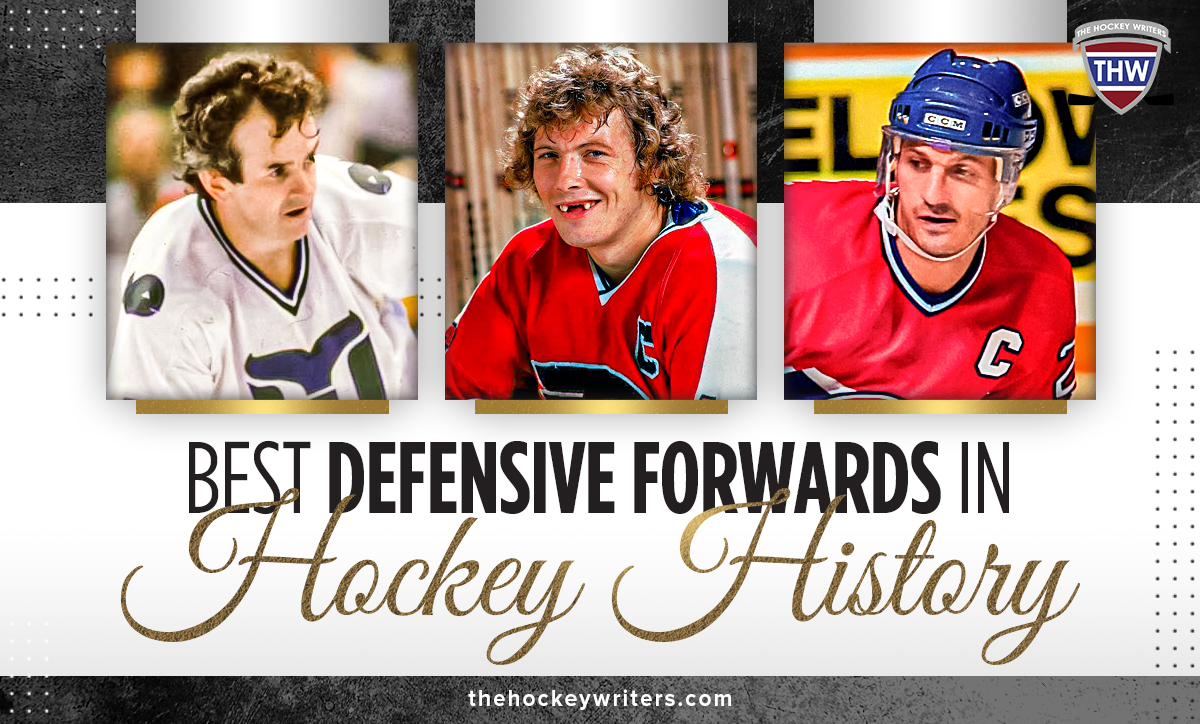
Though many don’t properly recognize it as a defensive trait because of its forward-moving aggressiveness, forechecking was one of Keon’s greatest specialties thanks to his great speed and deft skating ability. He played a major role in keeping the newly-founded “offensive defenseman” in check because of his great closing speed and lateral agility.
He was elite or near-elite in terms of offensive ability, including a wicked backhand release that left many goalies perplexed, but it was the little things that made Keon such a renowned defensive forward. His great faceoff ability, his aggressive penalty killing and his profound ability to raise his game to another level when it mattered most, are the things that set him apart.
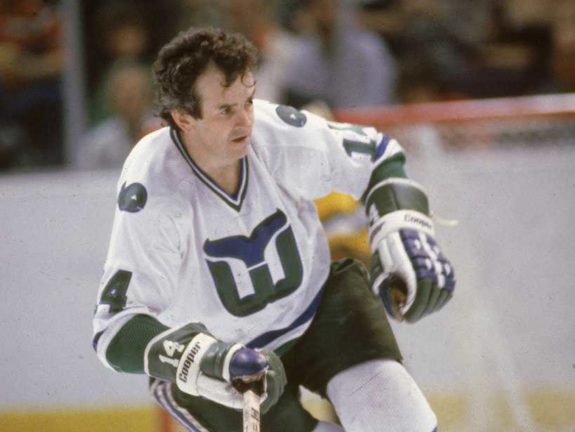
Though the Selke Trophy did not exist through most of Keon’s career, Ultimate Hockey (by Weir, et al., a very good collection of information) retroactively awarded three Selke Trophies for his efforts in the 1960s. This is of even more note because the authors of the book often favored purely defensive players from the era, so Keon – a two-way player if one calls for such designations – being selected multiple times is really a testament to his defensive mastery.
Quips & Quotes:
“He is the most valuable player in the NHL, the best centre and the most consistent guy in the business.” – Punch Imlach
“He’s too nice for me to start with.” – Stan Mikita on why he doesn’t tangle with Keon
“I like scoring, but I get just as big a kick out of checking. It’s a challenge between the other player and me.” – Keon on his affinity for defensive play
In a 1971 NHL coaches’ poll: Keon tied for first in the category of best checker, finished second as best penalty killer and second as best skater.
#7: Claude Provost
The Habs right winger of the 1950s and 1960s is far less heralded than the names that are associated with the Montreal Canadiens of the era: Jean Beliveau, Doug Harvey, Boom Boom Geoffrion, even Maurice Richard – in his twilight – was still lighting up net custodians when Provost joined the league. There are names associated with the Montreal Canadiens as a franchise, names associated with all-time greatness and then there are the “below the line” guys that make things work behind the scenes…Claude Provost falls into the latter category.
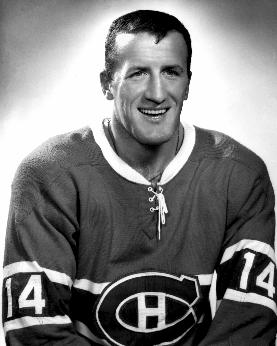
The Montreal native had the unenviable task of being matched up against most of the Hall of Famers that weren’t dressed in the Bleu, Blanc et Rogue in hockey’s golden era. He was designated as a four-time retro Selke winner (1958, 1964, 1965, 1966) for his terrific efforts in stymieing the best the world had to offer at the time on a nightly basis. He was a key piece of nine Stanley Cup championships for Montreal.
Some of his finest toiling came in the playoffs too. His work against the venerable Bobby Hull in the 1965 Stanley Cup Final rates very highly on the list of all-time offensive disemboweling. Hull, who led the NHL in goals seven times in a 10-year span, was severely limited by Provost throughout the seven-game affair.
Hull scored one even-strength goal in the whole Finals, it came with 1:12 to go in the third period of game 4 giving the Blackhawks a 4-1 lead. The only other goal from Hull in the series was in the same period of the same game on the power play, and contemporary reports suggest that Provost was not even out there for the power-play marker. One power-play goal and one goal of little consequence was all Hull could muster on Provost in seven tries, yet he still led the playoffs in goals and points otherwise!
Quips & Quotes:
“Claude’s was the finest defensive job I’ve ever seen.” – Gump Worsley on Provost’s kyboshing of Hull in 1965.
“While many forget to mention [him] as one of the greatest Habs of all time, it should be noted without his selfless team play and willingness to the dirty work on a team loaded with superstars, the Montreal Canadiens wouldn’t have been as successful during the 1950s and 1960s without Claude Provost.” – Hockey Historian Joe Pelletier
#6: Jack Walker
Perhaps the least-known name on the list, Jack Walker played just two NHL seasons in the 1920s. His claim to fame was on the Coast in the Western Canadian professional hockey circuits (plus a couple of early seasons in the Eastern pro rinks of the NHA before World War I). Walker was an industrious, clean, and tough player who made his mark on the game with his patented “hook check” that helped to shut down opposing stars.
In the Hockey Hall of Fame-backed list of retro Conn Smythe winners, Walker was awarded the 1925 retro Smythe for not only his scoring exploits but for his ability to shut down the league’s brightest star, Howie Morenz. Ultimate Hockey awarded retro Selke Trophies as well for the Western leagues before everything merged into the NHL sometime later and Walker had no shortage of them. He was designated the winner in five times in the PCHA (1916, 1917, 1918, 1920, 1924), once in the WCHL (1925) and once back East in the NHA (1914). The book rated him the best defensive forward and best “shadow” of the 1910s.
Though some may scoff at the notion of a player from so far back or one that played before the forward pass had been fully liberalized, it’s unfair to punish a player just for the year of his birth. He was a star among his peers as a defensive forward and should be recognized as an all-time great.
Quips & Quotes:
“Jack Walker of the Detroit Cougars, a thoughtful, brainy type of player, is generally credited with being the inventor of the poke check.” – Pittsburgh Press, Dec. 9, 1927
“In purely defensive play, Jack Walker with his clever hook check was the Seattle star. Walker took the puck away from the best stickhandlers the Flying Frenchmen could produce as easily as taking off his hat…” – The Morning Leader, Mar. 19, 1917
“Jack Walker drew applause for his nifty checking. He took the puck from Cleghorn after the latter had carried it the length of the ice.” – Edmonton Journal, Mar. 27, 1919
“Hockey owes much to players like Jack Walker.” – Ottawa Citizen, May 3, 1927 after comparing him favorably to the great Frank Nighbor.
#5: Craig Ramsay
Though a winger, Craig Ramsay was a remarkable defensive player and penalty killer for the Buffalo Sabres from 1971 to 1985. A perennial iron man, Ramsay registered perfect attendance for nearly a decade: 776 consecutive games in all. All the while, he played a gritty game that involved a lot of hard skating and harder matchups.
Renowned for playing mistake-free hockey, Ramsay would pressure the opponent’s breakout into turnovers and capitalize readily. Though I’m not a fan of raw plus/minus numbers, it is interesting that a player matched up against the league’s best competition night in and night out would be a plus-328 for his career and never once have a season as a minus in 14 NHL campaigns.
In coaches’ polls from the 1970s and 1980s, Ramsay ranked at or near the top of the heap for designations such as: best checker, best defensive forward and best penalty killer. His dogged work was aided by his great hockey sense. The Selke Trophy did not exist for all of Ramsay’s career and he was awarded the prize just once in 1985 – which was more of a career achievement award than anything else. However, even into the later stages of his career, he was regularly voted in the top five for the award (7 times out of a possible 8 years that the award’s existence coincided with his playing career).
There’s a fair claim that there’s a case statistically (especially when factoring in the quality of teammates) for Ramsay to be rated higher than Bob Gainey. The contemporary opinion even has a bit of a tough time deciding, though it leans towards Gainey and so do I, but it’s certainly worth an even closer look. Recent debates could have been strung up between, say, David Backes and Ryan Kesler or Jonathan Toews.
It’s tough to find any knocks in Ramsay’s resume, the only one that I can strongly discern is that the old Buffalo Memorial Auditorium where the Sabres used to call home wasn’t the full 200 x 85-foot rink that NHL protocol called for. As a result of the smaller surface, Ramsay would have a slightly easier time as a defensive forward while the offense had less space to maneuver in.
Quips & Quotes:
“A lot of people thought Ramsay’s line was Buffalo’s best in the playoffs, with Ramsay their club’s top Conn Smythe Trophy candidate.” – Bernie Parent after facing the Sabres in 1975 Stanley Cup Final
“Hey, anybody would be happy to have a guy who does as thorough a checking job as Ramsay does, makes no mistakes, and gets you more than 20 goals a year for nine consecutive years.” – Scotty Bowman
“It was Ramsay, a far less compelling player to watch but a far more effective one on the ice, who deserved this trophy…” – The Hockey Compendium (1987)
#4: Guy Carbonneau
The latest, as far as this list goes, in a long line of Montreal Canadiens defensive greats is right-handed center Guy Carbonneau. He was a complete player, but when it came right down to it, he sacrificed offensive glory for defensive greatness. Renowned for his penalty killing, shot-blocking, faceoff mastery and ability to shut down, or at least slow down, the high-flying centers of his era (Gretzky, Lemieux, Yzerman, to be brief with the list), the three-time Stanley Cup winner was also a three-time Selke Trophy winner – additionally, he finished in the top-five in voting six more times.
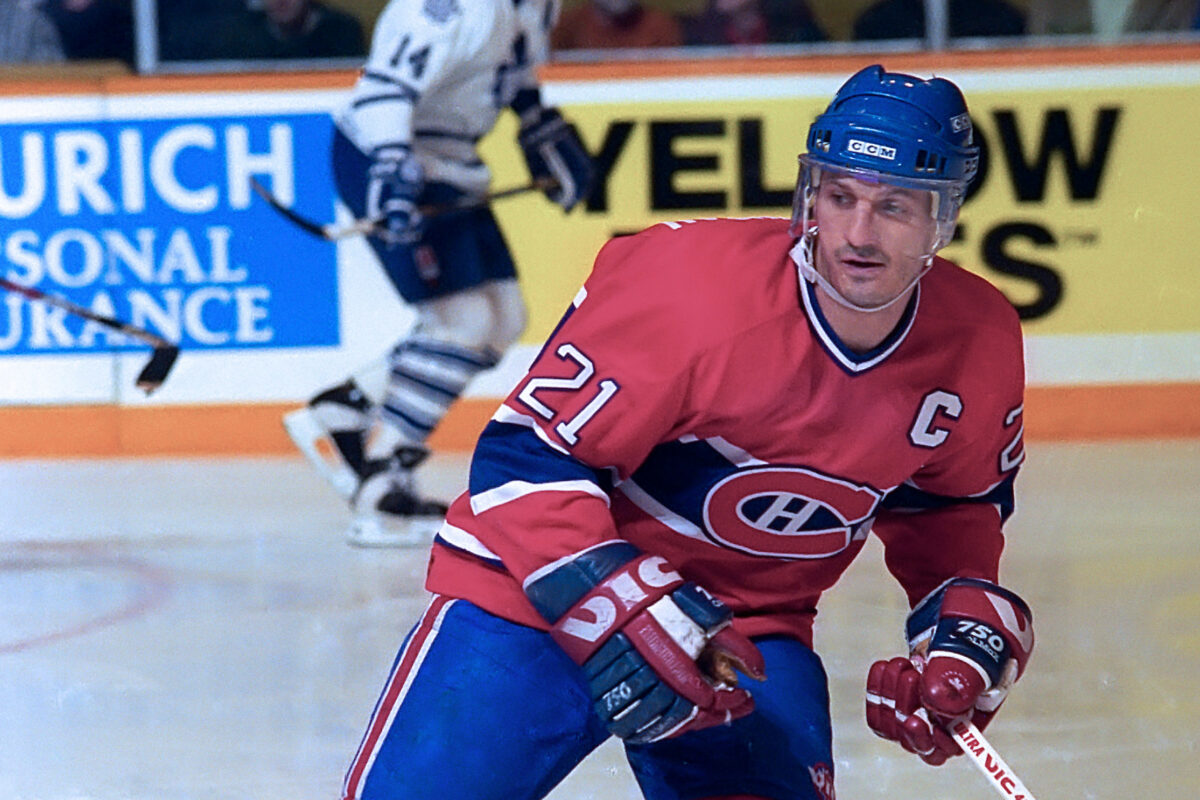
A supremely high-scoring player in juniors and in the AHL before being called up to the NHL, Carbonneau had terrific vision and a sneaky shot that could have been used in a more offensive role if that were his true calling. However, his hockey sense, anticipation and team-first, self-sacrificing style crafted him into one of the finest shutdown centers in history. NHL coaches’ polls from the mid-1990s saw Carbonneau ranked at or near the top of the sheet for best defensive forward, best penalty killer, best shot blocker and best faceoff man.
Though historically, it’s a little unfair of a metric because of the expansive reach of the Stanley Cup Playoffs today (16 teams make the postseason now, only six existed in all 50 years ago), but Carbonneau is a veteran of 231 postseason contests. Among forwards, Claude Lemieux with three more and Mark Messier with five more are the only ones that have appeared in playoffs games more often. Overall, Carbonneau’s mastodonic total is seventh all-time (Chris Chelios, Nicklas Lidstrom, Patrick Roy, and Scott Stevens being the others not yet named).
Quips & Quotes:
“Players like him love the game for all the right reasons.” – Ken Hitchcock on Carbonneau’s drive to compete and win above all else including fame and fortune.
“Guy Carbonneau, who has become a defensive edition of Wayne Gretzky with his amazing anticipation…” – Montreal Gazette, May 2, 1986
“Guy! Guy! Guy!” – Montreal Forum patrons chanting for Carbonneau’s heroics in the 1986 Stanley Cup Playoffs
#3: Bob Gainey
Left winger Bob Gainey’s impact on the ice could easily have had him at number one on the list. In terms of pure defense, not including other criteria (such as puck possession), Gainey has as good of a claim as anyone to be at the top. Though it might be the stuff of myth or legend, some may remark that the Frank J. Selke Trophy, awarded to the forward who demonstrates the most skill in the defensive component of the game, was created just to honor his career. Myth or not, it’s a distinct rarity that an award is even remotely attributable to one man’s contributions to the game.
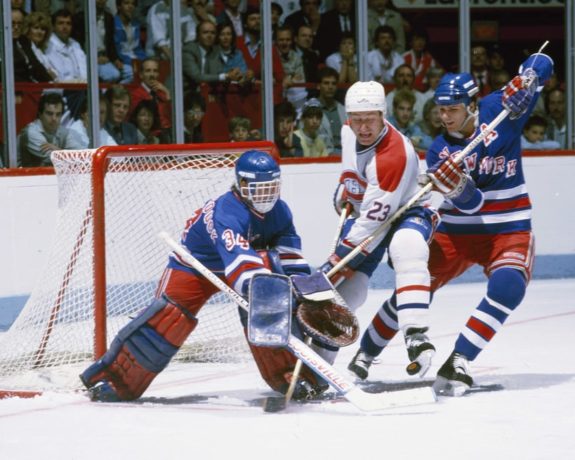
Gainey patrolled the ice for the Montreal Canadiens from 1973 to 1989, amassing five Stanley Cup rings in the process and the 1979 Conn Smythe Trophy as playoff MVP. Gainey’s speed and in-your-face puck pressure was especially useful in the days when a new brand of defensemen was taking charge – headed up by the esteemed and honorable Bobby Orr. All told, Gainey was a coach’s dream and the opposition’s nightmare.
Fittingly, he won the first four consecutive Selke Trophies and it’s assumed that he would have won it in 1977 as well had it existed. He featured highly on the aforementioned coaches’ polls from the time for his skating, his checking and his ability to kill penalties. He was a tenacious player who finished his checks cleanly and effectively and largely steered clear of the penalty box despite his rugged stylings.
Although he never recorded even a 25-goal or 50-point season, Gainey was inducted into the Hockey Hall of Fame and had his #23 jersey retired by the Montreal Canadiens.
Quips & Quotes:
“…Gainey is technically, the most complete player in the world…” – Soviet coach Viktor Tikhonov, though the exact words through translation has been debated, the message is clear.
“He took me off my game and made me play too quickly against Montreal. I don’t think I played nearly as well at a Bob Gainey tempo as I did [my own].” – Denis Potvin
“If I could be a forward, I would want to be Bob Gainey” – Ken Dryden
#2: Frank Nighbor
The last – err, first – two players on the list are there, in part, because they used their unique defensive skillsets to propel them to being the best player in the world for a noteworthy stretch of time. Frank Nighbor may be the most underrated player in the history of the sport. He jumped into the NHL as soon as it formed in 1917-18, though his previous success in the NHA and PCHA is noteworthy as well. The right-hander is largely credited with inventing the poke check or at least co-founding it with his more Western-based counterpart Jack Walker. Offensively, Nighbor was a demon too and it’s possible that he pioneered use of the slapshot long before Boom Boom Geoffrion did. Also a praiseworthy playmaker, Nighbor retired as the all-time assist leader in the regular season and playoffs combined at a time when assists weren’t given out like candy on Halloween night.
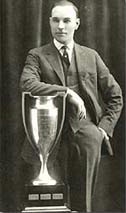
The admiration of Nighbor from fans, writers, players, coaches and managers alike is astounding. Clint Benedict, one of the pioneers at the goaltending position in Ottawa, gave Nighbor credit for his easier workload (Benedict played with Nighbor for seven seasons and led the league in wins six times, goals against average five times and shutouts all seven times) often saying, “There’s the best goaltender in the league,” as he motioned towards Peerless Frank, the Pembroke Peach.
He was the recipient of the very first Hart Memorial Trophy for league MVP in 1924 and the very first Lady Byng Trophy – hand-picked (not voted on) by NHL President Frank Calder – in 1925. From the same sources as above, Nighbor was adjudged to be the retro Selke recipient on six occasions between 1919 and 1928, plus one more in 1916 while he was employed in the NHA (the NHL’s direct predecessor). Further, it is believed Nighbor would have captured two additional Hart Trophies – 1917 and 1922 – had the award have been born a few years prior.
The retro awards are an inexact science, but the contemporary praise this defensive forward received from his peers is not at all debatable.
Quips & Quotes:
“There is no player in professional hockey who stood higher in the estimation of the experts and fans for general all-round ability combined with clean play and gentlemanly conduct on and off the ice than Frank Nighbor.” – Hockey historian Charles Coleman
“So far ahead of all hockey players in defensive ability, in starting plays and in out-guessing the opposition is Frank Nighbor that it would be almost a shame to mention another in the game at the present time. There is only one “Old Master” and aspiring players have a star to aim at.” – Ottawa Citizen, Feb. 8, 1929
“I won the [Hart Trophy], but Nighbor is the greatest player in hockey.” – Howie Morenz after being presented the 1928 Hart Memorial Trophy.
“Frank Nighbor, whom sports writers and other experts agreed was the best forward in hockey of all time, was preparing to leave the game and return to his native Pembroke.” – The Star, Dec. 14, 1931
#1: Bobby Clarke
Never has the NHL seen a greater blend of skill, tenacity, work ethic and truculence then had been seen in Bobby Clarke. He embodied the spirit of the Broad Street Bullies in the mid-1970s and, along with Bernie Parent, hand-delivered a championship to a title-hungry city that may well have starved to death without him. Though a silky playmaker in his own right, when Clarke didn’t have the puck he all but bludgeoned offense to a bloody pulp.
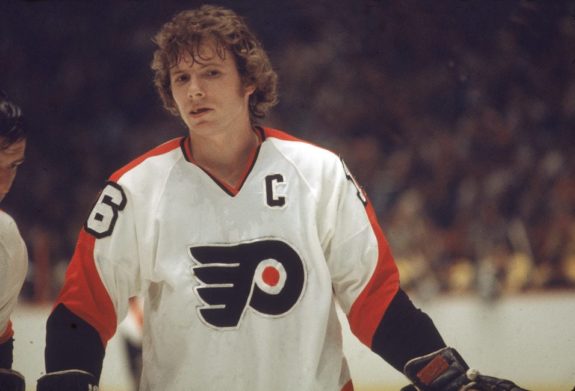
If a panel of coaches throughout history got together and created their ideal player, when the paint dried and the dust settled, Bobby Clarke’s toothless grin would be in full display. Unsurprisingly, opposing coaches thought the world of him according to polls from the time. Dropping his name so often that you’d swear it would singe the skin otherwise:
- Best Checker: 1973, 1974, 1976
- Best Forechecker: 1981
- Best on Faceoffs: 1973, 1976, 1979, 1981
- Best Penalty Killer: 1974, 1976
- Hardest Worker: 1971, 1974, 1976, 1979
- First Player to Build a Team Around: 1976
- Hart Trophy: 1973, 1975, 1976
- Ted Lindsay (then, Lester B. Pearson) Award: 1973
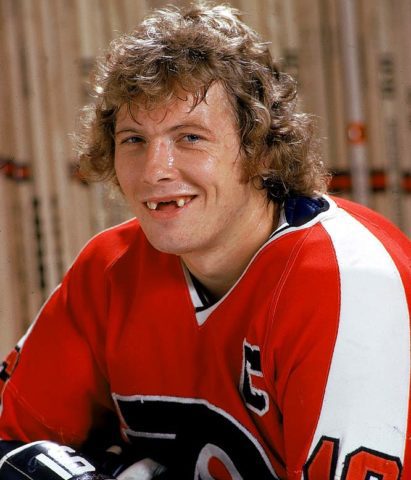
The above doesn’t account for things that he finished runner-up for and it’s almost misleading because these coaches’ polls weren’t readily available from every season. He received sizable nominations for his smarts and his playmaking as well, not to mention a copious amount of Selke votes (though it didn’t exist until halfway through his career). He finished top-10 in Hart Trophy voting for two-thirds of his career (10 of 15 seasons) despite never leading the league in points.
According to statisticians who have far more ability than I, it’s estimated that in 1975 and 1976, the Flyers outscored their opposition by a ratio of 5 to 1 when Clarke was out there, when he wasn’t out there: just 3 to 2. Despite playing an obscene amount of time in all situations for the Flyers, Clarke was only on the ice for 19 even-strength goals against in 1975 and 22 in 1976. To put it in some perspective, that’s a combined 41 goals. Pavel Datsyuk, resident Selke expert, was on the ice for 43 against in just one season (his best by the metric, 2008) while playing less time than Clarke, against worse competition than Clarke, in a far lower scoring era than Clarke…all the while Clarke led the league in assists both seasons which Datsyuk was fairly close to doing, but ultimately did not.
Truly, it was staggering just how important Bobby Clarke was to the Flyers as a defensive forward and to Canada in international competition (Valeri Kharlamov and Frantisek Pospisil may vote in a secret ballot against the notion though).
Quips & Quotes:
“[He’s] the dirtiest player in hockey” / “If I had Clarke on the Canadiens, we would have won six or seven Cups in a row…” – Scotty Bowman
“…No one personified the Philadelphia Flyers better.” – Hockey historian Joe Pelletier
This article was originally published in Feb. 2013.

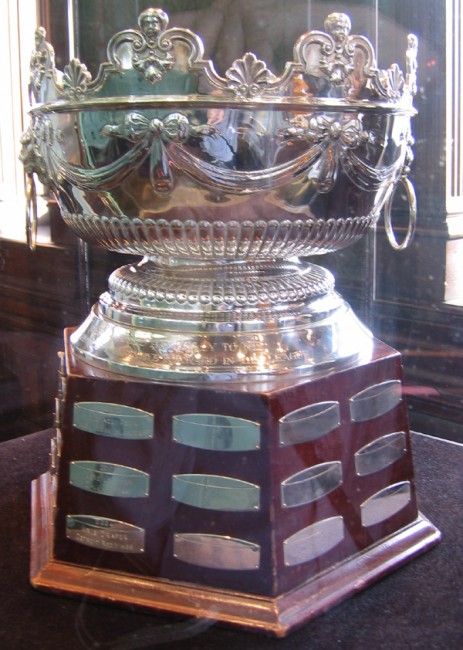
What about The Turk Derek Sanderson.
number 5 :)